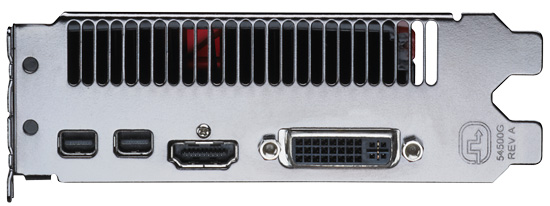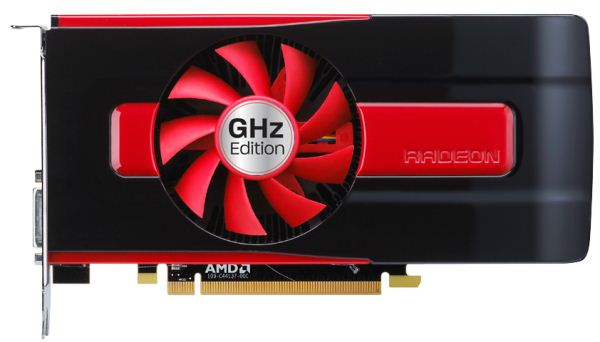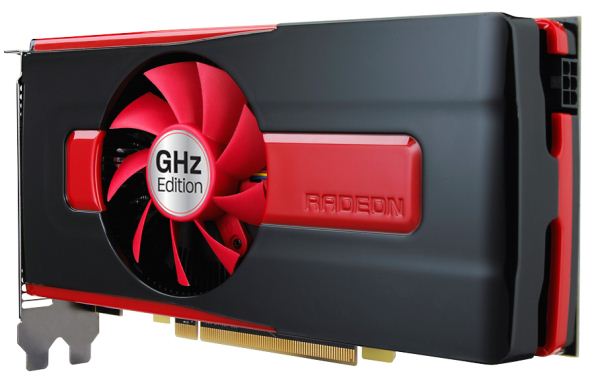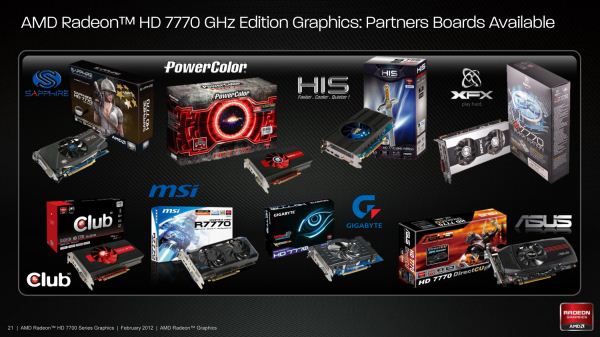AMD Radeon HD 7750 & Radeon HD 7770 GHz Edition Review: Evading The Price/Performance Curve
by Ryan Smith & Ganesh T S on February 15, 2012 12:01 AM EST- Posted in
- GPUs
- AMD
- HTPC
- GCN
- Radeon HD 7000
Meet the Radeon HD 7770 GHz Edition
The second card launching today is the Radeon HD 7770 GHz Edition. Compared to the 7750 it’s based on a fully enabled Cape Verde GPU and features a higher core clock of 1GHz, versus 800MHz on the 7750.
Starting as always with the cooler, for the reference 7770 AMD has gone with something that is best described as half of a blower. The shroud is completely enclosed on the sides, but due to the position of the fan the card exhausts hot air out of both the front and the rear of the card, which is something that’s common for dual-GPU cards such as the 6990 but atypical for a midrange video card. Heat transfer is provided by a basic black aluminum heatsink, while the fan is embedded in the middle of the heatsink.
As for the card itself, it’s effectively an extended version of the 7750. Like the 7750 the card is equipped with 4 256MB 5GHz Hynix GDDR5 RAM chips, along with some additional VRM circuitry to handle the higher 100W power limit for this board. External power is provided by a single 6pin PCIe power socket, while at the top of the card there is a single CrossFire connector. This is actually down from 2 connectors on the 5700 series, which comes as no great surprise as virtually no one ever used tri-CF with the 5700 series in the first place. Overall the card is 8.25” long with no notable shroud overhang, making it the same length as the 5770’s PCB.
Meanwhile for display connectivity AMD is using the same configuration as we’ve seen on the 7900 series: 1 DL-DVI port, 1 HDMI port, and 2 miniDP ports. Unlike the 7900 series AMD’s not requiring their partners to include any adaptors, so buyers with 2 DVI monitors will almost always be on their own. The presence of 2 miniDP ports means that the 7770 has quite a bit of flexibility in driving various displays, however as with the 7900 series if you want to drive more than 4 displays you will need a MST hub, the release of which is still some time off.

As for partner cards, as with the 7750 all of AMD’s partners are doing their own thing. No one will be using AMD’s reference cooler, though PowerColor in particular will be using a cooler similar to it. Everyone else will be using their own double-wide coolers, most of which will be open air as we typically see in this market segment. Like the 7900 series AMD is relying on the 7770 having some degree of overclockability, so there will be a number of factory overclocked cards taking advantage of this.
Finally, I wanted to quickly touch on the naming of the 7770. The official name of the 7770 is the Radeon HD 7770 GHz Edition; with the last bit being AMD’s latest marketing push. Starting with the 7770, AMD is going to be branding every card with a reference clock at or above 1GHz as a “GHz Edition” card to capitalize on the fact that they’ve hit 1GHz. Thus in spite of what the name implies there won’t be a 7770 non-GHz Edition card, as it’s a tagline rather than a true suffix necessary to differentiate cards.
With that said, while hitting 1GHz on a GPU is a notable accomplishment for AMD and should not be ignored, it’s not going to be particularly important in the grand scheme of things. The embarrassingly parallel nature of rendering means that GPU performance isn’t nearly as tied to clockspeeds as CPU performance is, as you can always lay down more functional units to improve performance. Clockspeeds do need to go up over time due to the limited parallelization of the command processor, but otherwise GPU performance has never been heavily dependent on clockspeeds.



















155 Comments
View All Comments
Dianoda - Wednesday, February 15, 2012 - link
Yeah, I jumped on that BB/Visiontek HD4850 512MB deal as well. Bought the card about a week before the official launch and at a $50 discount on top of that. Timing was perfect, too, as I had just finished my build, short one video card (borrowed a 3850 from a friend for a few weeks).I finally upgraded from that card to a 6950 2GB (BIOS modded to 6970) about a month ago - Skyrim was just too much for the 4850 to handle @ 2560x1440. The 6950 2GB is a great card for the price if you're willing to perform the BIOS mod (and don't mind rebate forms).
nerrawg - Thursday, February 16, 2012 - link
Exactly! I bought 2 4850's in the UK in 2009 for £65 ($95) each - best GPU purchase I have made in 12 years! I now have a single 6870 that I bought in 2011 for £120- but its not really an upgrade at all. Thought I would wait and get a second one cheaper but now I don't think that will happen2008-2009 was the sweet spot of a decade for Desktop GPUs. The way things are going with the Desktop (AMD bullsnoozer etc. etc.) I fear that it might have even been the sweet spot of GPU performance for the decade to come as well. I would love to see some massive progress in graphics, but it seems that the all the "suites" care about now days is "smart" this and "smart" that. I can't really blame them either, because until pc programmers get their act together and actually start making apps and games that push what is possible on current hardware I don't see any reason why I need 2X the GPU and CPU compute power every 1-2 years.
Come on guys - we are all waiting for the next "Crysis" - if it doesn't come then it might spell the end of the enthusiast desktop
StrangerGuy - Wednesday, February 15, 2012 - link
AMD having a fail product at $160 that couldn't even beat an almost 1.5 year old $150 6870 isn't surprising considering they are also the ones with the cheek to price their FX-8150 at near 2600K prices.thunderising - Wednesday, February 15, 2012 - link
The only problem I have with AMD on this card is WHY THE LOW BANDWIDTH.The card performs nearly 10% faster when the memory is clocked at 6GHz QDR (TPU reviews) and 15% with Core Clock matching XFX's OCed Speed.
I think that 6GHz memory modules would have taken the HD7770 a long way ahead. The performance boost would have been enough to hit HD6850 performance, or beat it in all cases, and at that point, this card at 159$ would make sense.
Right now, until the price hits about 129$, this doesn't make sense.
chizow - Wednesday, February 15, 2012 - link
But you get GCN, 28nm and a bottle of verdetard?Zoomer - Wednesday, February 15, 2012 - link
GCN is worse than useless for gamers and non compute users.jokeyrhyme - Wednesday, February 15, 2012 - link
I think I've built my last system with an AMD CPU. Intel completely abused their monopoly and decimated AMD's success in the CPU department, and I don't think AMD will have an enthusiast-quality CPU ever again. :(That said, I think I will still use AMD GPUs for a while yet.
nVidia's Kepler may beat AMD later this year, but AMD actually has an open-source driver developer on staff and routinely publishes hardware documentation. AMD GPUs will probably have better support for Wayland than their nVidia counterparts due to these factors. If you use Linux and want to stay on the cutting edge, then I don't think picking nVidia is particularly wise.
ganeshts - Wednesday, February 15, 2012 - link
At least in the HTPC area, NVIDIA is miles ahead of AMD in the open source support department.Almost all Linux HTPCs capable of HD playback have NVIDIA GPUs under the hood, thanks to their well supported VDPAU feature.
AMD started getting serious with xvBA only towards the end of last year, and they still have a lot of catching up to do [ http://phoronix.com/forums/showthread.php?65688-XB... ]
Ananke - Wednesday, February 15, 2012 - link
AMD is several years behind NVidia on the compute side...actually they are nowhere as of today. The AMD 7xxx series is so ridiculously priced, it will not get an user base to be attractive for developers. Actually, I am at the point of considering NVidia cards for computing, despite that I hate their heat and power consumption.AMD had their chance and they blew it.
Besides, we shall see where the AMD ex-VP will go - that company most likely will be the next big player in graphics and high performance computing. Probably Apple.
PeskyLittleDoggy - Thursday, February 16, 2012 - link
In my country, company policy dictates you cannot leave your company and work for a competing company if you have valuable R&D knowledge. Thats part of the restraint of trade clause in your contract.Basically what I'm saying is, AMD's ex-VP will not be able to work in any company with a graphics department for 2 years if the contract is similar to mine. I can't remember now but some CEO was sued for that recently.